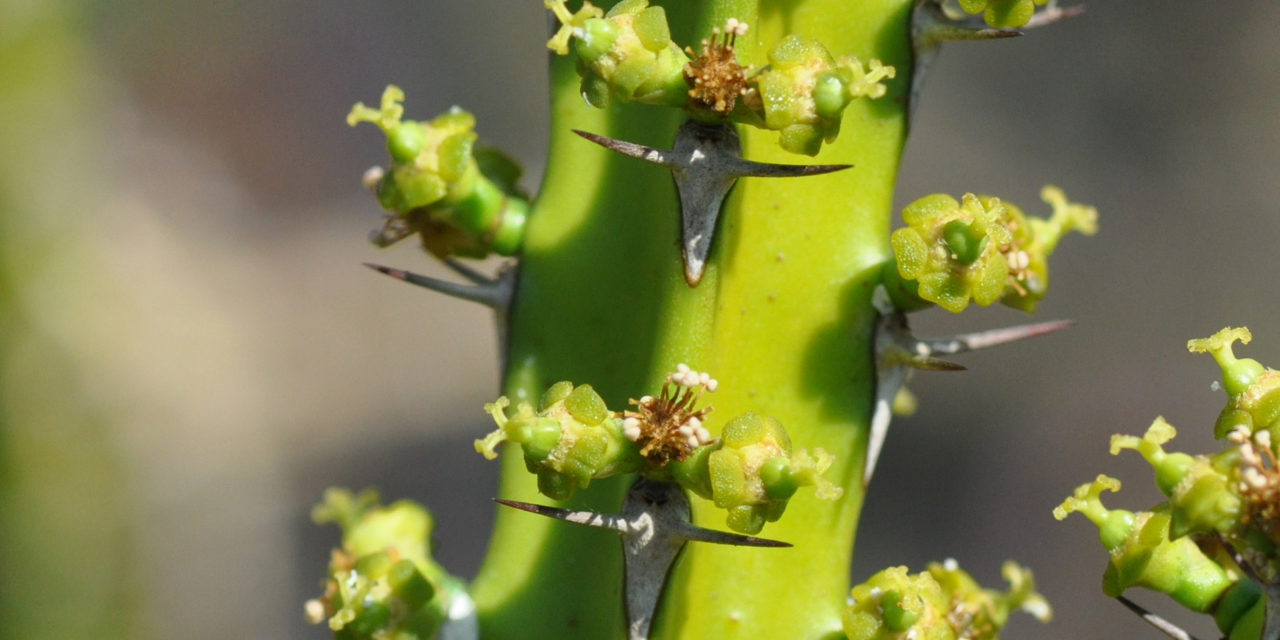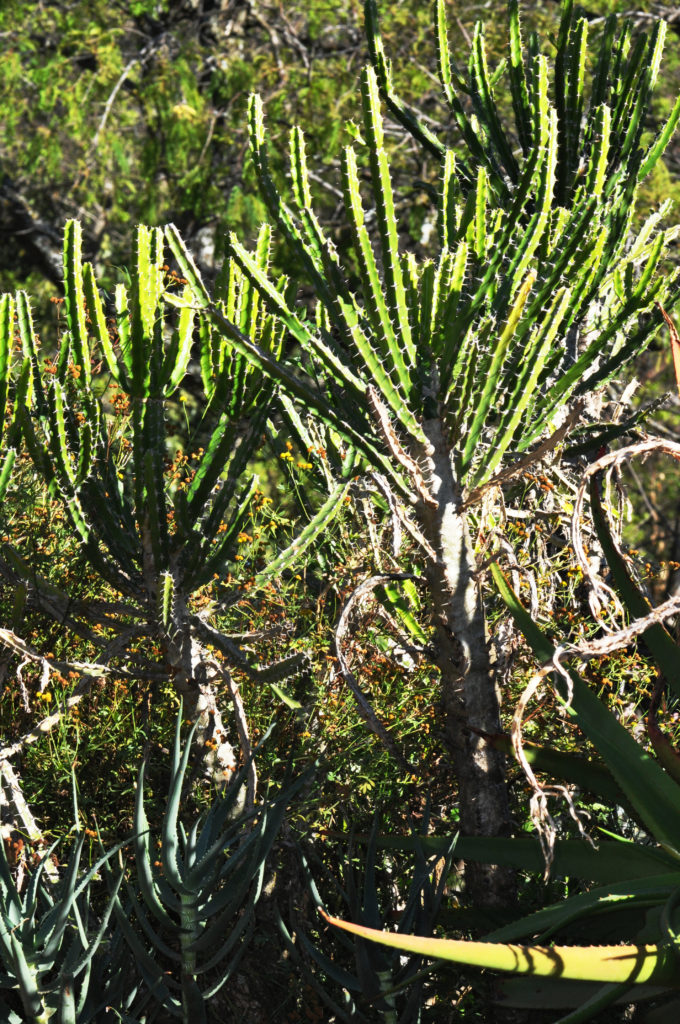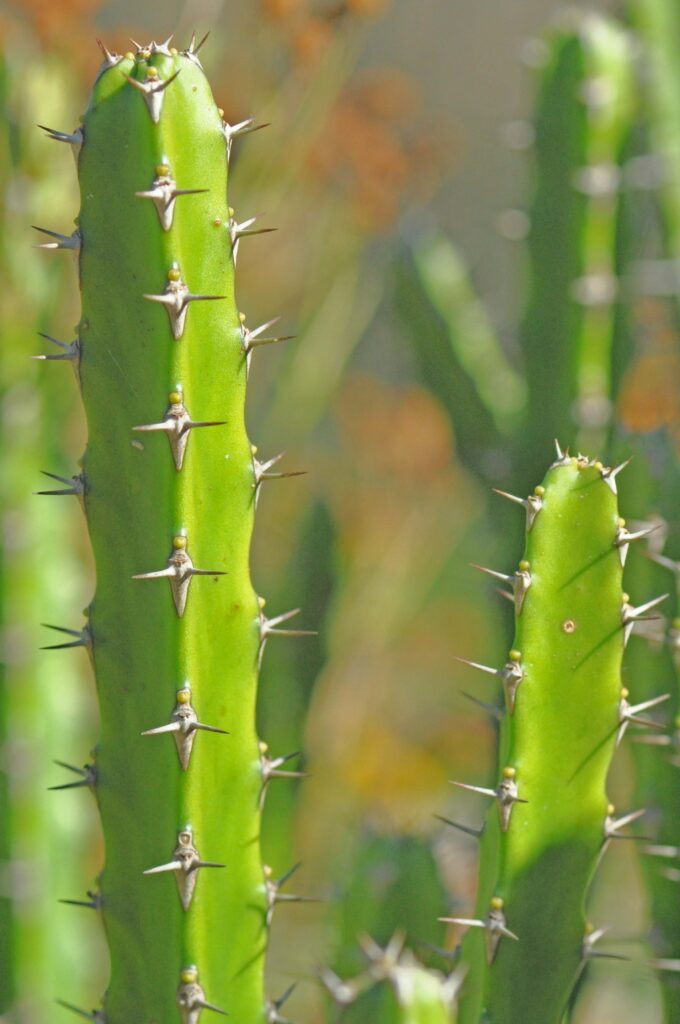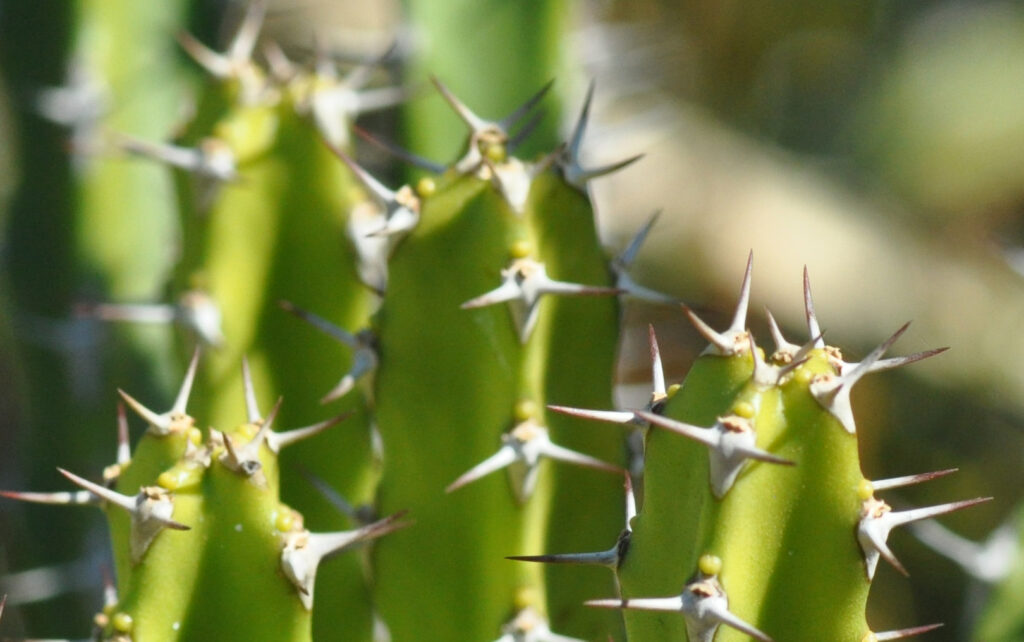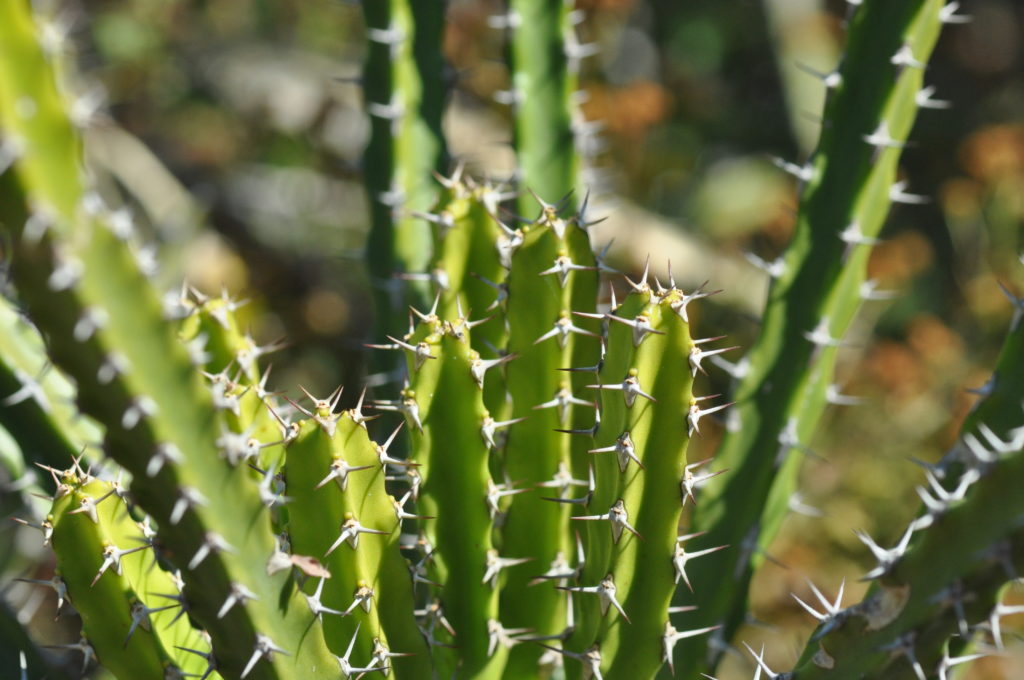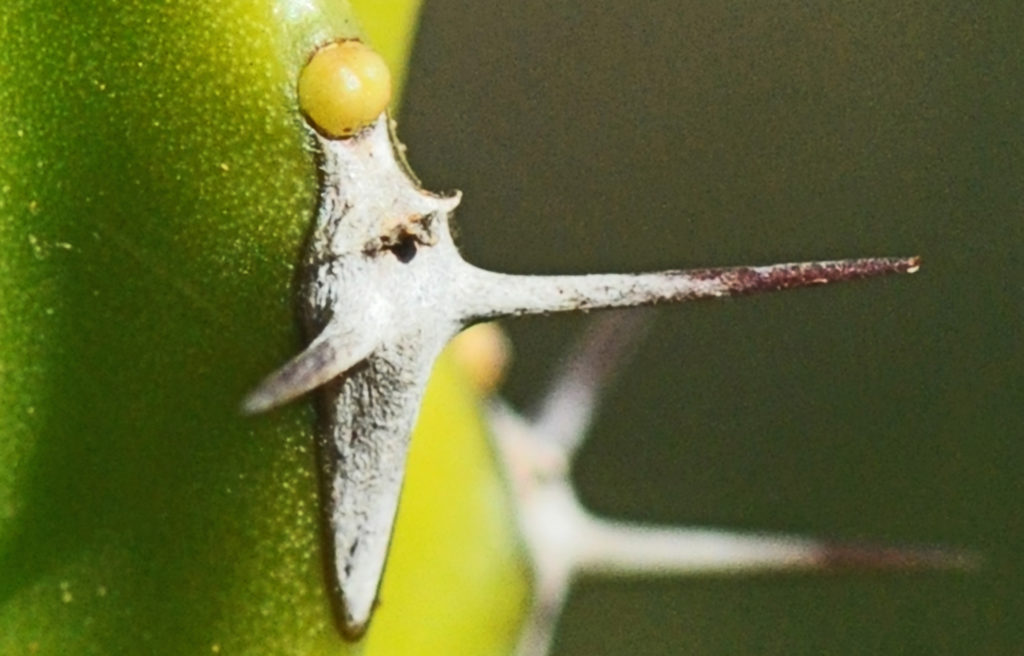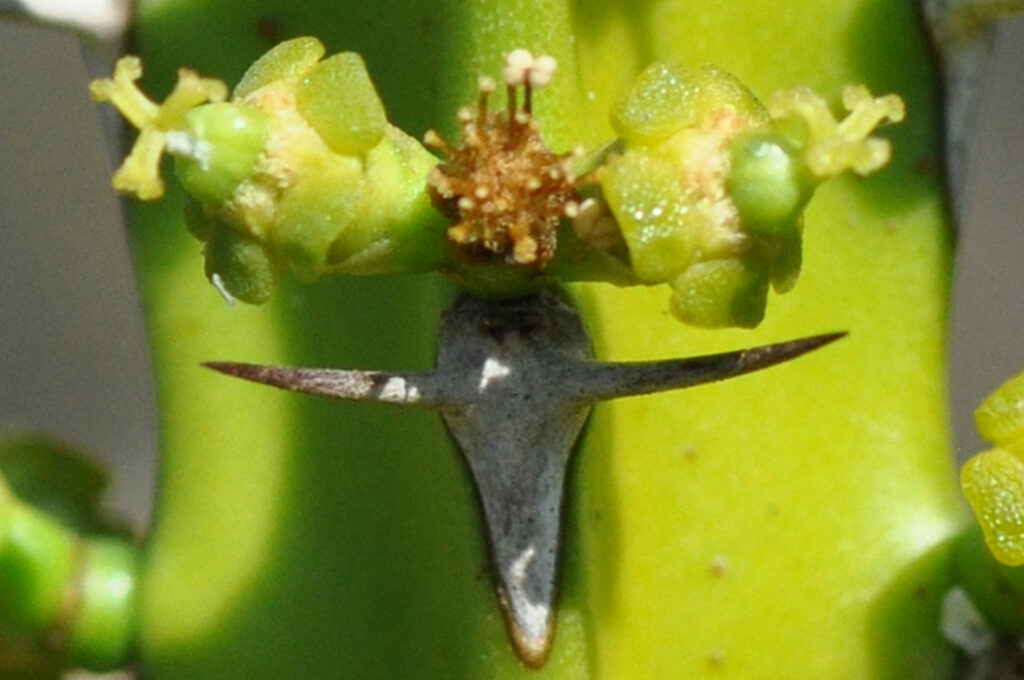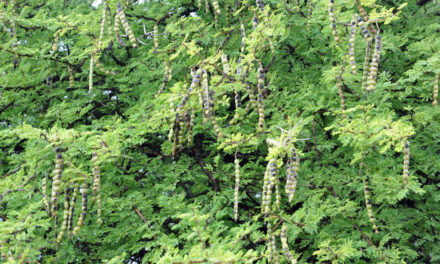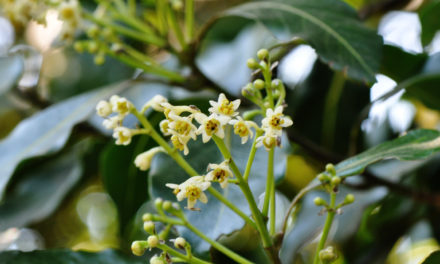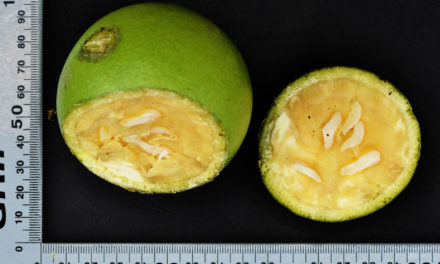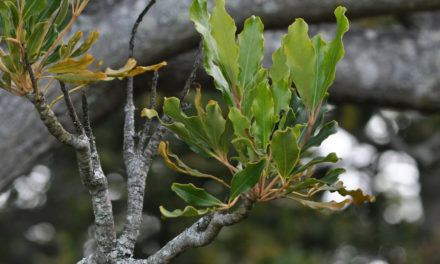General Info – summary
The robust candelabra-shaped Tree has toxic milky latex and is up to 12m high. 2-5 branches end in small crowns. Initially green branchlets are usually squarish. Young green stems have paired spines on separate horny spine shields. Short-lived Leaves are small. Much reduced unisexual yellow-green Flowers are in a cyathium and lack a perianth. Fruit: 3-lobed woody capsule, dehiscing to release seeds.
Description
Euphorbia tetragona
SA Tree No. 354.
Common names: (Afr) Grootnoorsdoring, Groot-noorsdoring, Heuning-naboom, Naboom, Noorsdoring. (Eng) Honey Euphorbia, Map Tree, Square-stemmed Euphorbia, Tree Euphorbia. (isiXhosa) Umhlontlo. (isiZulu) Inhlonhlwane, Isiphapha, Umhlonhlo, Umhlonhlwane.
Family Euphorbiaceae (Euphorbias family e.g., the exotic poinsettia – Euphorbia pulcherrima). This family has about 275 genera and 7 500 species with a very wide distribution. In South Africa, there are 50 genera and 484 species. Apart from Antarctica, members of this family are present in all continents. This family has many herbs, and in the tropics, shrubs and trees, including succulents and climbers, are more common. Local tree containing genera on this website include Croton, Euphorbia, and Spirostachys. Leaves, when not rudimentary, are usually alternate, and simple. Stipules are usually present as hairs, glands or spines. Plants may be monoecious or dioecious. Inflorescences are situated terminally or in leaf axils. They are mostly in cymes (a broad, more or less flat-topped, determinate flower cluster, with central flowers opening first). The unisexual flowers are monoecious or dioecious, and regular. Colourful bracts may be present below the flowers.
Name derivation: Euphorbia – after Euphorbus (50BC-AD19): physician to the king of Mauretania (NW Africa). tetragona – 4 angles: refers to the number of angles on the branchlets. Bowie first collected euphorbia tetragona in 1823 and he introduced it to KEW. As a result, it has been known botanically for close to 200 years. There are many species of the Genus Euphorbia in South Africa.
Conservation: National Status: L C. (Least Concern). Assessment Date: 2005 (R.H. Archer and J.E. Victor). The impact of trunk destruction of the tree by the black rhinoceros may have to be investigated.
Tree
This euphorbia (photo 83) is a robust, spiny, succulent, candelabra-shaped Tree up to 13m high and 15cm wide. The terminal branchlets may collectively span 2m in diameter and each branchlet is 2,5 – 5cm wide. The Trunk is either round or slightly 4-5 angled with grey Bark. It may be single but is frequently divided from near ground level into 2-5 stout, stem-like Branches topped with small crowns. Young trees are deep green (photo 83). The usually 4-angled Branchlets (small branch or division of a branch – especially a terminal division; usually applied to branches of the current or preceding year) are angled and usually distinctly square (photo 84) or 5 angled but almost flat sided and appear square or lightly concave. Branchlets are slender, up to 5cm in diameter, shallowly constricted with margins slightly extended. Young green stems are conspicuously spiny (photo 323). Pairs of widely separating Spines (photo 322) are on separate warty spine shields in this Euphorbia (photo 84). Each spine is up to 1,2cm long. Old branchlets may lack spines. Poisonous Latex (milky sap) is released from damaged parts. An underground Tuber is present and may exceed 4cm in diameter.
- 83. 2014/06/03. Walter Sisulu NBG. Photo: David Becking.
- 84. 2014/06/03 Walter Sisulu NBG. Photo: David Becking
- 323E. 2014/06/24 Walter Sisulu NBG. Photo: David Becking.
- 323. 2014/06/24 Walter Sisulu NBG. Photo: David Becking.
- 322. 2014/06/24 Walter Sisulu NBG. Photo: David Becking.
Leaves
The usually small Leaves are short-lived. Stipules (basal appendage of the petiole) may be transformed into spines. Some Euphorbia, in arid regions have an additional method of photosynthesis called CAM (Crassulacean acid metabolism) photosynthesis. This involves closing the Stoma (structure utilising 2 guard cells, which, unlike lenticels, can control the gaseous exchange between the plant and the surrounding atmosphere) during the day – the opposite of most plants. In this way, they substantially reduce loss of water due to evaporation. The stomata then open at night to absorb carbon dioxide, which is stored until daylight where light is then used to complete the photosynthesis process. CAM photosynthesis also occurs in other plants including pineapples, the spekboom (Portulacaria afra) and the cacti. In some plants, the process can be switched on and off.
Flowers
The yellow-green Flowers are part of one Inflorescence (a group or cluster of flowers arranged on a stem). The apparent single flowers are a combination of separate, unisexual, male and female flowers, bracts and nectar glands. All flowers lack a Perianth (calyx and corolla). Each of the usually 3 inflorescences (photo 51 under Fruit) is called a Cyathium. In the centre of each cyathium is a single unisexual Female Flower. This reduced flower rests on a short stalk on which develops the single pistil (with a single trilocular ovary, pollen receiving stigmas and 3 persistent supportive styles). Surrounding the central single female flower are many Male Flowers. Each male flower has a single filament supporting a single pollen-producing anther that has 2 thecae (pollen sacs – central cyanthium in photo – photo 51 under Fruit)). The male and female flowers do not produce their own nectar. Separate Nectar Glands produce the nectar and are often brightly coloured. The exterior of each cyathium is surrounded at the base not by sepals or petals but by 5 bracteoles (small, united bracts). Their upper tips are free and initially cover the opening of the involucre (a ring or whorl of bracts immediately below the flowers). Nectar glands produce a great deal of nectar. This attracts many insects, which are the agents of pollination. (Jul-Sep).
Fruit
The somewhat spherical, 3-lobed Fruit is about a 9mm in diameter Capsule (a dry fruit resulting from the maturing of a compound ovary, which usually opens at maturity by one or more lines of dehiscence). It becomes woody before releasing the seeds by explosively dehiscing. (Sep-Nov). In photo 51 just above the paired spines, 3 Cyathia can be seen. In the younger central one, the remains of the stamens (here the male flowers) are visible. On either side of this, the two cyathia are developing into fruit. Here the 3 persistent stigmas are still visible, as are the 5 Bracteoles.
- 51. 2014/09/23. Walter Sisulu NBG. Photo: David Becking.
Distribution & Ecology
This succulent plant is Located in dry, sub-tropical and coastal areas in southern Africa, specifically Eastern Cape from Utenhage – NW of Port Elizabeth. Here trees can be seen on the banks of the Gamtoos River). Moving eastwards and north, they also appear in KwaZulu-Natal. Euphorbia tetragona is Endemic (restricted to this particular geographic location) in South Africa. The plant often grows together with E. triangularis and E. grandidens. It is drought resistant and fairly frost hardy. Black rhinos may target and push over these trees.
Ethnobotany
The Latex of this plant is toxic if ingested. It is also highly irritant to the skin and eyes and may cause blindness. Wash affected areas of the skin with soapy water or milk. Dried plant material retains toxicity. Do not collect or use nearby wood for making a braai. Propagation is by planting seeds or truncheons. Young trees are easy to transplant. This is one of the so-called rubber trees. Unfortunately, the quality is insufficient for commercial use. The honey produced by bees is reported to have an unpleasant burning taste. Many species of Euphorbia have this “problem”.
References
Archer, R.H. & Victor, J.E. 2005. Euphorbia tetragona Haw. National Assessment: Red List of South African Plants version 2020.1. Accessed on 2023/05/24.
Boon, R. 2010. Pooley’s Trees of eastern South Africa. Flora and Fauna Publications Trust, Durban.
Coates Palgrave, M. 2002. Keith Coates Palgrave Trees of Southern Africa, edn 3. Struik, Cape Town.
Lawrence, G. H. M, 1951. Taxonomy of Vascular Plants, The Macmillan Company, New York. Tenth Printing 1965.
Palmer, E. & Pitman, N. 1972. Trees of southern Africa, Balkema, Amsterdam, Cape Town.
van Wyk, B. & van Wyk, P. 1997 Field guide to Trees of Southern Africa, Struik, Cape Town.
http://www.thefreedictionary.com)
http://practicalplants.org/wiki/Euphorbia_tetragona
https://en.wikipedia.org/w/index.php?title=Crassulacean_acid_metabolism&oldid=1154175758

